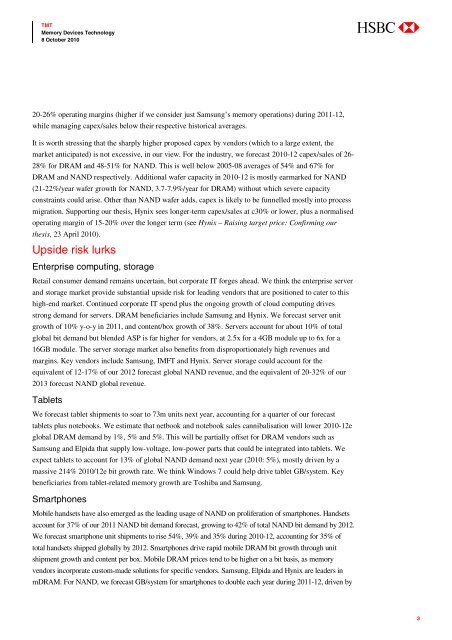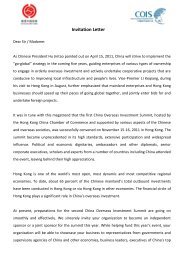You also want an ePaper? Increase the reach of your titles
YUMPU automatically turns print PDFs into web optimized ePapers that Google loves.
TMT<br />
<strong>Memory</strong> Devices Technology<br />
8 October 2010<br />
abc<br />
20-26% operating margins (higher if we consider just Samsung’s memory operations) during 2011-12,<br />
while managing capex/sales below their respective historical averages.<br />
It is worth stressing that the sharply higher proposed capex by vendors (which to a large extent, the<br />
market anticipated) is not excessive, in our view. For the industry, we forecast 2010-12 capex/sales of 26-<br />
28% for DRAM and 48-51% for NAND. This is well below 2005-08 averages of 54% and 67% for<br />
DRAM and NAND respectively. Additional wafer capacity in 2010-12 is mostly earmarked for NAND<br />
(21-22%/year wafer growth for NAND, 3.7-7.9%/year for DRAM) without which severe capacity<br />
constraints could arise. Other than NAND wafer adds, capex is likely to be funnelled mostly into process<br />
migration. Supporting our thesis, Hynix sees longer-term capex/sales at c30% or lower, plus a normalised<br />
operating margin of 15-20% over the longer term (see Hynix – Raising target price: Confirming our<br />
thesis, 23 April 2010).<br />
Upside risk lurks<br />
Enterprise computing, storage<br />
Retail consumer demand remains uncertain, but corporate IT forges ahead. We think the enterprise server<br />
and storage market provide substantial upside risk for leading vendors that are positioned to cater to this<br />
high-end market. Continued corporate IT spend plus the ongoing growth of cloud computing drives<br />
strong demand for servers. DRAM beneficiaries include Samsung and Hynix. We forecast server unit<br />
growth of 10% y-o-y in 2011, and content/box growth of 38%. Servers account for about 10% of total<br />
global bit demand but blended ASP is far higher for vendors, at 2.5x for a 4GB module up to 6x for a<br />
16GB module. The server storage market also benefits from disproportionately high revenues and<br />
margins. Key vendors include Samsung, IMFT and Hynix. Server storage could account for the<br />
equivalent of 12-17% of our 2012 forecast global NAND revenue, and the equivalent of 20-32% of our<br />
2013 forecast NAND global revenue.<br />
Tablets<br />
We forecast tablet shipments to soar to 73m units next year, accounting for a quarter of our forecast<br />
tablets plus notebooks. We estimate that netbook and notebook sales cannibalisation will lower 2010-12e<br />
global DRAM demand by 1%, 5% and 5%. This will be partially offset for DRAM vendors such as<br />
Samsung and Elpida that supply low-voltage, low-power parts that could be integrated into tablets. We<br />
expect tablets to account for 13% of global NAND demand next year (2010: 5%), mostly driven by a<br />
massive 214% 2010/12e bit growth rate. We think Windows 7 could help drive tablet GB/system. Key<br />
beneficiaries from tablet-related memory growth are Toshiba and Samsung.<br />
Smartphones<br />
Mobile handsets have also emerged as the leading usage of NAND on proliferation of smartphones. Handsets<br />
account for 37% of our 2011 NAND bit demand forecast, growing to 42% of total NAND bit demand by 2012.<br />
We forecast smartphone unit shipments to rise 54%, 39% and 35% during 2010-12, accounting for 35% of<br />
total handsets shipped globally by 2012. Smartphones drive rapid mobile DRAM bit growth through unit<br />
shipment growth and content per box. Mobile DRAM prices tend to be higher on a bit basis, as memory<br />
vendors incorporate custom-made solutions for specific vendors. Samsung, Elpida and Hynix are leaders in<br />
mDRAM. For NAND, we forecast GB/system for smartphones to double each year during 2011-12, driven by<br />
3
















